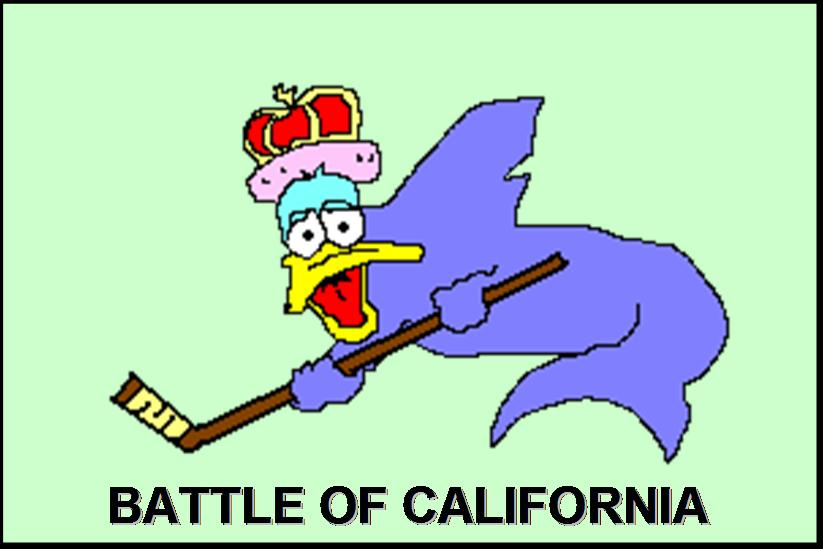Head-scratcher of the day
 It's kind of fluky that the Ducks lost in a shootout last night to the Sharks, because earlier yesterday I had been chatting with Mike Chen about his treatment of shootouts in his proposed standings post. Mostly I was just telling Mike that I have been keeping spreadsheets of game results over the past two seasons, so whereas he was having some trouble separating regulation wins from overtime wins from shootout wins, I had that stuff pretty available at my fingertips.
It's kind of fluky that the Ducks lost in a shootout last night to the Sharks, because earlier yesterday I had been chatting with Mike Chen about his treatment of shootouts in his proposed standings post. Mostly I was just telling Mike that I have been keeping spreadsheets of game results over the past two seasons, so whereas he was having some trouble separating regulation wins from overtime wins from shootout wins, I had that stuff pretty available at my fingertips.
At any rate, I took a quick look at some of these results, and there are two major trends (comparing this year to last year) to note:
1. Fewer games that are going to overtime are being decided within the 5-minute 4-on-4 extra session. Last year, 281 games ended with two teams tied at the end of regulation, and 136 (48%) were decided before a shootout. This year, 274 games have been regulation ties, and only 113 (41%) were ended before the sideshow. That's not really the head-scratcher, but I thought it was worth mentioning that on the surface, teams appear to be getting more conservative in their 4-on-4 defense.
2. Home teams are less successful this year in the shootout than they were last year. The main difference between shootouts last year and shootouts this year is that last year, home teams always shot second, and this year, home teams have the option of whether to shoot first or second. You'd figure that the option would enable home teams to improve their shootout success, but the numbers don't really bear that out. Last year, home teams won 75 of 145 shootouts (52%); this year, home teams won 76 of 161 shootouts (47%).
Now I don't really have data about whether home teams opted to shoot first or second in shootouts this year (JavaGeek?), but it is awfully suspect that giving home teams this option has in fact decreased their success rate.
So, if this really is the case, why do home teams opt to shoot first? Or maybe more to the point, why did Randy Carlyle decide to have the Ducks shoot first last night (and lose)?









5 comments:
Assuming the play-by-play records the shoot-out chronologically then:
Teams choose to shoot first 65% of the time
Winning percentage for shoot-first was: 50%
Winning percentage for shoot-second was: 44%
I'll put a team by team breakdown on my site later...
Sample size is small, so differences are not significant. Last season it was always shoot-second and that had winning % of 52%.
Hmm, interesting, I suppose. I guess the lesson is there really is no inherent home ice advantage when it comes to shootouts, which is pretty intuitive.
It may explain why we see less being decided in OT, the road team senses its best opportunity is to wait for the shootout?
I can't really think of a game this year the Ducks have chosen to shoot last, Carlyle seems to always elect to go first.
I would think it is to take pressure off of his shooters, but then put more on his goalie. I would rather have player feel more pressure then the goalie though. But that seems like the obvious reason to do it, maybe there is something else.
Earl-Do you keep stats on how often the Ducks score with their goalie pulled? Do you think their chances of getting an extra point are better in a shoot out win or by pulling their goalie in OT? I mean if the single point is guaranteed and the Ducks usually suck in shoot outs, I'd just go all out in OT.
Actually, I do keep those stats, ONLY for the Ducks, funny you asked. But I should stop you in your tracks right now, because you SHOULD NEVER PULL YOUR GOALIE IN OVERTIME (except maybe on a delayed penalty). If you get scored on into an empty net in OT, you do NOT get the loser point.
I remember that from when they started the extra point in OT.
With 6 skaters on the ice, the Ducks have scored 5 goals and allowed 2 empty-netters. That includes PP 6-on-4s as well.
But I'm comfortable enough with the guaranteed point that I don't need to risk it for a slightly higher possibility of a second point.
Post a Comment